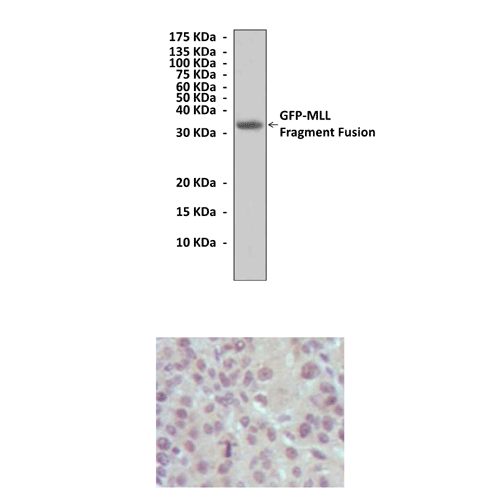Anti-MLL: Mouse Mixed Lineage Leukemia Antibody |
 |
BACKGROUND The MLL (Mixed Lineage Leukemia) gene encodes a DNA-binding protein with histone methyltransferase activity that plays an essential role in early development and hematopoiesis. As the catalytic subunit, It forms a multiprotein complex that mediates both methylation of 'Lys-4' of histone H3 (H3K4me) complex and acetylation of 'Lys-16' of histone H4 (H4K16ac). MLL can bind DNA either directly (sequences enriched for AT rich or non-methylated CpG) or indirectly (through sequence specific transcription factors such as E2Fs), provide interfaces for the assembly of multi-protein complexes. It was shown that MLL forms complexes with Menin (a tumor suppressor), cell cycle regulators (E2Fs and HCF-1), Pc-G proteins (BMI-1 and HPC2), HDACs (Histone Deacetylases), Cyp33 (a nuclear cyclophilin), CBP/P300 and MOF (histone acetyltransferase), INI1/SNF5 (chromatin remodeling factors) and core components of the H3K4 histone methyl transferase (WDR5, RbBP5 and Ash2L). In the complex, it specifically mediates H3K4me, a specific tag for epigenetic transcriptional activation. It has weak methyltransferase activity by itself, and requires other component of the MLL1/MLL complex to obtain full methyltransferase activity. It has no activity toward histone H3 phosphorylated on 'Thr-3', less activity toward H3 dimethylated on 'Arg-8' or 'Lys-9', while it has higher activity toward H3 acetylated on 'Lys-9'. It is required for transcriptional activation of HOXA9. It promotes PPP1R15A-induced apoptosis. Moreover, MLL itself is regulated by the cell cycle machinery. MLL undergoes a specialized bimodal degradation resulting in its biphasic expression through the cell cycle.52 this unique expression is conferred by SCFSkp2 and APCCdc20, two cell cycle specific E3 ligases.1
In addition to the aforementioned complexity of MLL gene regulation, It has been showed that the full length MLL precursor (MLLFL) undergoes evolutionarily conserved site-specific proteolysis by Taspase1 to generate the mature MLLN320/C180 consisting of processed N-terminal 320 kDa (MLLN320) and C-terminal 180 kDa fragments (MLLC180) that heterodimerize through the FYRN domain of MLLN320 and the FYRC plus SET domains of MLLC180. Taspase1-mediated cleavage of MLL is an evolutionarily conserved regulatory event that enables the spatiotemporal control of MLL downstream targets.2
Chromosomal translocations involving the human MLL gene are recurrently associated with high-risk acute leukemias. MLL translocations correlate with specific disease subtypes (acute myeloid and acute lymphocytic leukemias), a specific gene expression profile, and outcome (favorable or poor), depending on the particular MLL fusion. Approximately 50 different MLL translocation partner genes have been identified, suggesting that the human MLL gene is a hot spot for illegitimate recombination events. During illegitimate recombination events, one MLL allele is reciprocally fused with one of the many translocation partner genes. The latter encode nuclear or cytosolic proteins that share only a little sequence homology; however, the fused portion of partner protein sequences is necessary to confer oncogenic potential. Leukemogenic MLL translocations encode MLL fusion proteins that have lost H3K4 methyltransferase activity. A key feature of MLL fusion proteins is their ability to efficiently transform hematopoietic cells into leukemia stem cells.3
In addition to the aforementioned complexity of MLL gene regulation, It has been showed that the full length MLL precursor (MLLFL) undergoes evolutionarily conserved site-specific proteolysis by Taspase1 to generate the mature MLLN320/C180 consisting of processed N-terminal 320 kDa (MLLN320) and C-terminal 180 kDa fragments (MLLC180) that heterodimerize through the FYRN domain of MLLN320 and the FYRC plus SET domains of MLLC180. Taspase1-mediated cleavage of MLL is an evolutionarily conserved regulatory event that enables the spatiotemporal control of MLL downstream targets.2
Chromosomal translocations involving the human MLL gene are recurrently associated with high-risk acute leukemias. MLL translocations correlate with specific disease subtypes (acute myeloid and acute lymphocytic leukemias), a specific gene expression profile, and outcome (favorable or poor), depending on the particular MLL fusion. Approximately 50 different MLL translocation partner genes have been identified, suggesting that the human MLL gene is a hot spot for illegitimate recombination events. During illegitimate recombination events, one MLL allele is reciprocally fused with one of the many translocation partner genes. The latter encode nuclear or cytosolic proteins that share only a little sequence homology; however, the fused portion of partner protein sequences is necessary to confer oncogenic potential. Leukemogenic MLL translocations encode MLL fusion proteins that have lost H3K4 methyltransferase activity. A key feature of MLL fusion proteins is their ability to efficiently transform hematopoietic cells into leukemia stem cells.3
REFERENCES
1. Liu, H. et al: Gene Dev. 21:2385-98, 2007
2. Liu, H. et al:Cancer Biol. Ther. 8:1206-13, 2009
3. Yeoh, E.J. et al: Cancer Cell 1:133-43, 2002
2. Liu, H. et al:Cancer Biol. Ther. 8:1206-13, 2009
3. Yeoh, E.J. et al: Cancer Cell 1:133-43, 2002
Products are for research use only. They are not intended for human, animal, or diagnostic applications.
Параметры
Cat.No.: | CP10171 |
Antigen: | Purified recombinant human MLL fragments (aa3714-3969) expressed in E. coli. |
Isotype: | Mouse IgG1 |
Species & predicted species cross- reactivity ( ): | Human, Mouse, Rat |
Applications & Suggested starting dilutions:* | WB 1:1000 IP n/d IHC 1:200 ICC n/d FACS n/d |
Predicted Molecular Weight of protein: | 180 kDa |
Specificity/Sensitivity: | Detects MLL proteins without cross-reactivity with other related proteins. |
Storage: | Store at -20°C, 4°C for frequent use. Avoid repeated freeze-thaw cycles. |
*Optimal working dilutions must be determined by end user.
Документы
Информация представлена исключительно в ознакомительных целях и ни при каких условиях не является публичной офертой








